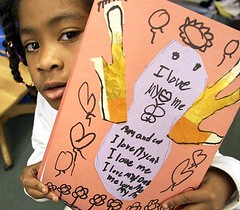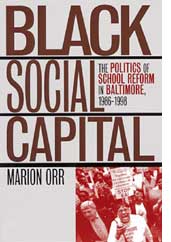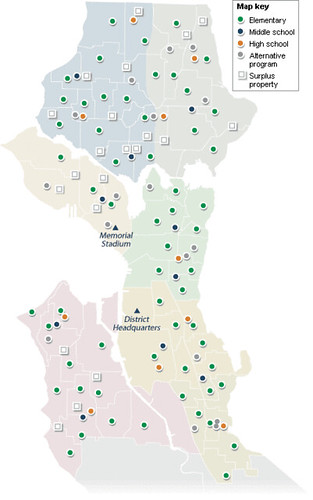Other places to learn from, when thinking about DC public school closures
 THOMAS JAMES HURST / THE SEATTLE TIMES. Martin Luther King Elementary School first-grader Dasia Burkett shows a project she made for her mom. The school has just 104 students.
THOMAS JAMES HURST / THE SEATTLE TIMES. Martin Luther King Elementary School first-grader Dasia Burkett shows a project she made for her mom. The school has just 104 students.People have asked me about other school districts where they are closing schools, and I have mentioned Seattle, completely forgetting that Baltimore is going through the same school closing process right now.
1. Yesterday's Baltimore Sun has an excellent interview, "Race, politics and the schools," with Professor Marion Orr, who wrote his dissertation, later expanded into a book, on the Baltimore Public Schools.
The book Black Social Capital: The Politics of School Reform in Baltimore, 1986-1998, draws on data gathered as part of an 11-city study of urban school reform. Judging from the description of the book on the website, it appears to be an essential read for understanding urban school reform and center city political dynamics. Professor Orr's book applies urban regime theory (which I have written about before; while I am a proponent of the "Growth Machine" theory, I believe that the two theories are complementary, that regime theory explains how the Growth Machine works). From the book's website:
Orr's book challenges those who argue that social capital alone can solve fundamentally political problems by purely social means and questions the efficacy of either privatization or black community power to reform urban schools. Black Social Capital offers a cogent conceptual synthesis of social capital theory and urban regime theory that demonstrates the importance of government, politics, and leadership in converting social capital into a resource that can be mobilized for effective social change.

Some of the interesting points in the interview are:
(1) how control of the public school system was given to the black community in the city while the business and political leaders (the "Growth Machine") continued to focus on downtown and other economic development projects and wanted to maintain that power as the city became majority African-American (a similar point about DC is made in the book The Future Once Happened Here);
(2) that patronage in this agency was to be expected and understood, given that ethnic control of various municipal agencies and resulting patronage is a Baltimore (I would say "urban" or even general government) tradition;
(3) that control was ceded in a time of difficult financial circumstances--"It was really an inopportune time to get control."
(4) and how:
"Mayors are now beginning to see the danger of ignoring public schools. Now many of them are saying, "Please give me control over the schools," because they see that connection with economic development. When [Baltimore Mayor Martin] O'Malley was elected in 1999, he ran on a crime-fighting platform. He was going to stay away from the schools. It is cute to watch how this has played out.
To be fair, this was right after the state partnership legislation put limits on the mayor's authority in school affairs. But when I interviewed Mayor O'Malley a few years ago about his role in the school system, he told me that he played a very limited role, that his focus was on crime fighting.Now in his second term, he is talking about education. This is the shift you see in big-city mayors in the 21st century."
2. I have mentioned that Seattle is going through a public school closing process as well, although the school system doesn't face charter school competition similar to the DC Public Schools. So I decided to poke through some of the coverage of this in the Seattle Times and the Seattle Post-Intelligencer.
There are many interesting pieces, and this one from last year, "Budget shortfall forces tough choices at Seattle Public Schools," from the P-I, discusses center city school closing efforts in Seattle, and compares this to similar efforts in Pittsburgh and Minneapolis. From the article:
Determining criteria. Education experts and districts familiar with school closures say the criteria used vary, but typically include common considerations, such as the age of a school, current and projected enrollment, recent or planned improvements to the building and its suitability to deliver educational programs. Academic performance should also be a factor, said Mike Griffith, policy analyst for the Denver-based Education Commission of the States.
Since the federal No Child Left Behind Act imposes increasingly severe sanctions on schools not meeting performance goals, Griffith said, closing low-achieving schools makes sense. But those schools are frequently located in disadvantaged neighborhoods, he said, and often provide needed community supports.
"Especially in the bad neighborhoods, that seems to be the case," he said. "So you wouldn't want to close a school if it runs after-school programs and it's got a day care center and it's a seniors center on the weekend. It's part of keeping the community alive."
This is an important issue in DC. What I would rather have is a set of smaller schools, so that neighborhoods could retain elementary schools, in part for neighborhood stabilization and improvement efforts, despite dropping enrollments., which makes uneconomic larger school formats.
DC once had many small elementary schools, but in the 1950s-1970s, these schools were closed and consolidated into new larger facilities. Some of these old ("historic") and usually smaller schools were demolished. Others were sold off or given over to other functions--3 schools in my neighborhood are used as shelters or other public facilities, and another is now an upscale apartment building. (Another had been converted into housing a couple decades ago.)
The larger buildings that replaced the smaller schools are now utilized at far under capacity, for at least three reasons:
(1) decline in the number of school aged children living in the city;
(2) better enforcement vis-a-vis non-residents who were enrolling their children in city schools, usually in the neighborhoods where the parents grew up, and where grandparents still live;
(3) competition from charter schools.
Plus, demographic trends project continued drops in the number of school-aged children in the center city. While the Post-Intelligencer published a chart of city schools, with their enrollments, and a graphic comparing this to capacity, in "Closing Schools: Tough Choices," I haven't seen similar information published in DC, although the Post graphic accompanying the article on school closure proposals did list that information for those specific schools.
In 1954, the neighborhood north of Stanton Park/Maryland Avenue NE and south of Florida Avenue had seven elementary schools and one junior high school, and most of the schools were small, although one, Logan elementary school, had about 1,000 students.
Today this area is served by two relatively large and underutilized schools (another large elementary school built in the 1950s is located here, but is used for out-of-area school functions; similarly Logan School next to Union Station is used for administration).
Getting back to Seattle, the article "Save schools? Trick is where else to cut: Seattle parents want other options, but all involve some pain," quotes the Schools' finance director:
"Our revenue keeps going up," Nielsen said, "but revenue isn't keeping up with expenses." A key reason, Nielsen said, is the collective impact of decisions the district has made since the 1970s about how to run the school system. To Nielsen, "The giant elephant in the room is the number of schools that we have."
Enrollment in Seattle is half what it was 40 years ago, but the rate of school closings hasn't paralleled that decline. To be in line with the state average of students per building, Seattle would need to close 25 of its 94 schools, Nielsen said.
Seattle Public Schools enrollment has fallen from 86,000 students in 117 schools in 1970 to 46,000 students in 94 schools. The Seattle Times did the Post-Intelligencer one better, creating a fabulous interactive graphic depicting all the city's schools, with an exceptional amount of data on each, including enrollment and capacity.
Seattle Public Schools by the numbers.
 Seattle Public Schools owns more than 100 properties--nearly all of which are school buildings--citywide. Now, for the second time in a year, district officials are weighing whether to close schools. The Seattle Times analyzed statistics from the school district and the state Office of the Superintendent of Public Instruction and provided data on each property, linked to the map below. Facts about each school building--its age, size, capacity--are displayed along with details about the students and academic programs within it. The map is divided into Seattle Public Schools' planning regions.
Seattle Public Schools owns more than 100 properties--nearly all of which are school buildings--citywide. Now, for the second time in a year, district officials are weighing whether to close schools. The Seattle Times analyzed statistics from the school district and the state Office of the Superintendent of Public Instruction and provided data on each property, linked to the map below. Facts about each school building--its age, size, capacity--are displayed along with details about the students and academic programs within it. The map is divided into Seattle Public Schools' planning regions.______Clicking on one of the "dots" yields this (but in a fancier table)___
John Rogers Elementary School Facility statistics
Year built 1955
Year renovated -
Square feet - 36,266
Acres - 9
Capacity (seats) - 286
Classrooms - 16
Occupied space - 102.8%
Maintenance costs - $111,346
Busing costs - $84,170
Demographics
Asian - 13.3%
American Indian - 2.0%
Black - 13.3%
Latino - 9.9%
White - 61.6%
% on free and reduced-price lunch - 34.3%
Program statistics
Special programs -
Enrollment - 294
First-choice rankings, 2005 - 21
% of those who live in school's cluster - 5%
Students who passed 2005 WASL reading - 81%
Students who passed 2005 WASL math - 72%
Rate of student progress, reading - average
Rate of student progress, math - average
Program costs - $1,416,590
___________
Another article, which also mentions that Portland, Oregon and San Francisco are closing schools, "Will closing school doors open others?," makes the point that the need to close schools can also be an opportunity in (re)creating better schools.
Seattle Times columnist Danny Westneat, wrote a good column, "Closure strategy is valid," that echoes some of the things I've said or written about wrt DC. He writes:
One by one, or in large gaggles of color-coded T-shirts, the people took to the stage to denounce the plan to close some Seattle schools. The 300 parents and kids were rousing. Defiant. Occasionally outrageous. Some said closing these nine schools is a racist attack on black children. Or that it will rip out their neighborhood's heart. Or that their school is too great to deserve such a fate. What was striking was how little any of it spoke to the actual rationale behind the citizen-led plan to close schools.
Ever since a masochistic group of 13 volunteers announced its suggested school-closure list last week, it seems the whole point has been lost in emotional diatribes and conspiracy theorizing. Here's what I haven't heard anyone saying:
• These schools are on the chopping block because parents are rejecting them.
• For all the shrillness about racism, the reason more schools are slated for closure in the minority-heavy South End is far more mundane. It's because enrollment is declining there....
• Finally, let's cut the speeches about how closing these schools is an attack on these neighborhoods...
It's painful to close schools. But we need to. Seattle has the most space per student of any district in the state. We're about to have a school with fewer than 100 kids in it. It's time to stop cowering. And do something. Several districts in Oregon — Eugene, Portland — just closed schools amid great controversy. It took them just a few months to do it.
This list may be flawed. But it's the best one yet. It comes from the people. I say close at least some of these schools. If the School Board can't, then please, don't try again. Put a tax increase on the ballot and just admit we're going to be the priciest — and the roomiest — school system around.
Note that the Seattle School System attempted to close schools last year and it was controversial. So they scrapped the process, created a committee of citizens to make recommndations based on a public process. These recommendations, released within the last two weeks, and resulting from a process not too dissimilar from that used by the Department of Defense to close military facilties (Base Realignment and Closure--BRAC) are before the Seattle School Board now, for action.
Index Keywords: education



0 Comments:
Post a Comment
<< Home